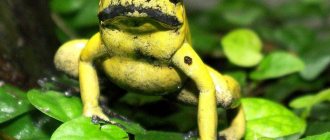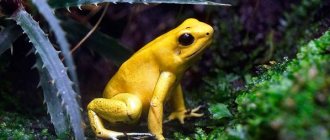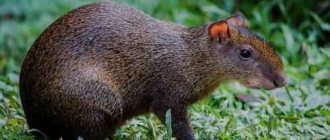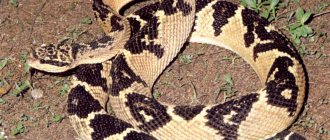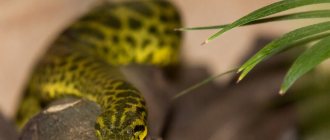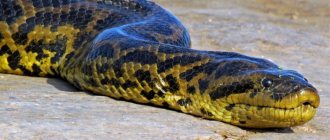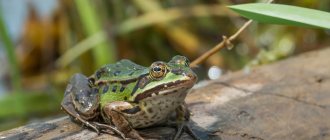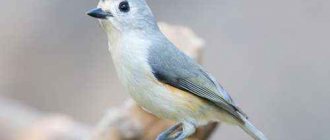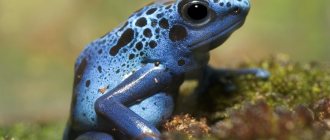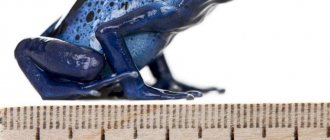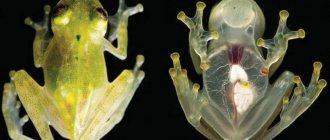Tree frogs are the most colorful representatives of the amphibian order - their colors range from yellow and green to red and blue mixed with black. Such a bright range is not just a quirk of nature, it is a signal for predators, warning of danger.
Producing a poisonous toxin that can paralyze, stun and kill even a large animal, tree frogs have firmly established themselves in the impenetrable tropical forests of Central and South America, where high humidity and a huge biodiversity of insects allow them to survive for more than 200 million years.
Having appeared on Earth at the same time as dinosaurs, frogs demonstrate extraordinary adaptation to the environment - painted in all the colors of the rainbow, they are practically invisible among lush vegetation and inedible for most representatives of the fauna.
Eventually, these birds were discovered to have feathers containing the same toxic molecules that frogs have in their skin. It is believed that both animals ate the same food. There are even some strong marine toxins that are often poisoned by people who are infested with crustaceans. This is often associated with harmful algae blooms in the oceans.
Meiototoxin is one of those deadly substances. Myototoxin is secreted by arterial algae, a species of marine plankton with a very complex structure. Mayototoxin is cardiotoxic and causes death by increasing the flow of calcium ions in the membranes of the heart muscle.
The Amerindians long ago learned to benefit from the poison of poison dart frogs, using it as a lethal substance to lubricate the tips of their hunting darts. Having pierced the frog with a stick, the Indians first held it over the fire, and then collected the droplets of poison that appeared on the skin of the animal into a container, after which they dipped the arrows in a viscous liquid. This is where another name for poisonous tree frogs came from - dart frogs.
Scientists are only isolating the relative toxicity of the substances, but they all seem to agree that botulism, derived from anaerobic bacteria, is the most toxic substance known to humans. The same paralysis is an essential feature of botulinum used for plastic surgery.
Low concentration injections stop some muscle activity and thus soften skin wrinkles. Of course, this procedure does not always end as desired - sometimes botulinum paralyzes the wrong muscles that you wanted.
Description and history of the breed
Darter frogs are small frogs, the size of which does not exceed 25 mm (on average 15-20 mm), the smallest frogs in the world.
With proper nutrition and living in good conditions, dart frogs grow to a maximum of 60 mm. The frog weighs only 2-3 g. The color is bright, has various shades, from yellow to blue. There are often spectacular black stains, specks, and red stripes.
Dart frogs are the smallest frogs in the world. The coloring, rarely found in the wild, is intended to warn that the animal is dangerous and poisonous.
The frog's legs are black and have triangular-shaped suckers. The poison dart frog's tongue is incredibly long, which allows it to hunt. A frog cannot hurt a person because it has no teeth.
Biodiversity on Earth
Vietnam. About 150 species of amphibians are common here; in 2003, 8 new species of frogs were found in the country.
Venezuela. The exotic state is sometimes called the “lost world” - many table mountains, difficult to reach for researchers, are distinguished by endemic flora and fauna. In 1995, a group of scientists undertook a helicopter expedition to the Sierra Yavi, Guanay and Yutaye mountains, where 3 species of frogs unknown to science were found.
Tanzania. A new species of tree frog, Leptopelis barbouri, has been discovered in the Ujungwa Mountains.
Papua New Guinea. Over the past decade, 50 unstudied species of tailless amphibians have been discovered here.
Northeastern regions of the USA. Habitat of the rare spider-like toad.
Madagascar. The island is home to 200 species of frogs, 99% of which are endemic - unique species not found anywhere else. The scientists' latest find, the narrow-mouthed toad, was discovered through a study of the soil and foliage of the jungle, during which they were able to identify the amphibian's excrement.
Colombia. The most outstanding discovery of scientists in this region is the species of tree frog Colostethus atopoglossus, which lives only on the eastern slopes of the Andes, in El Boquerón.
Argentina, Bolivia, Guyana, Tanzania and many other countries with a tropical climate and difficult landscapes are regions where scientists are constantly finding new subspecies of animals, including tailless amphibians - frogs. Possessing miniature sizes, arboreal representatives of the amphibian order are not only the smallest, but also the most dangerous animals in the world - modern zoologists are increasingly convinced of this.
In the humid forests of South and Central America you can find amazing frogs. Their sizes range from 7 to 1.5 cm. But thanks to the amazing, bright and rich coloring, it is impossible not to notice even the smallest representatives of this family.
These beautiful amphibians are called dart frogs. They all have one thing in common: small and large, multi-colored and plain, these amphibians are deadly poisonous, and the color that makes them stand out is a warning to the outside world about danger. Let's take a closer look at some species.
Lifestyle
Initially, dart frogs settled along the banks of streams, swamps and rivers. They love shady areas, so they are easy to spot in forests and mountains where it often rains.
They live both in low-lying areas and at altitudes up to 2000 m above sea level. Frogs spend time not only near the pond, but also in the trees. They easily overcome heights, move along branches and jump from tree to tree.
Charming leaf climber / Phyllobates lugubris
The species name of the inhabitant of the Atlantic coast of Central America fully corresponds to the appearance of the frog. Multi-colored stripes run along the black body, from yellow to bright golden.
Not as poisonous as other representatives of the leaf climber genus, but able to defend itself from natural enemies. Possessing poison, it does not hide much, so it can easily be found on forest paths and the banks of rivers and reservoirs.
They are distinguished by leaf climbers and huge bulging eyes on a relatively small head.
9
The benefits and harms of poison dart frogs
Tree frogs are needed by nature and are very useful. They destroy a large number of insects, thus reducing the number of crop pests. Despite the fact that they secrete a toxic mixture, frogs do not harm the environment.
But a person should avoid some types of poison dart frogs, because they can be poisonous.
The dart frog's venom can kill a person in half an hour.
When kept at home, the frog loses toxicity and becomes safe. This is possible with proper feeding and specially created conditions.
Dart frog toxin is popular in medicine. It is not yet used in medicines, but scientists are actively looking for uses for it. An antibiotic has already been developed, which is based on a frog toxin that can save you from serious diseases, and a product has been released that allows you to fight insects.
The mucus of the dye dart frog has an analgesic effect comparable to that of morphine. Scientists also plan to use it in the future.
What is batrachotoxin
This is a natural organic compound from the group of steroidal alkaloids. Batrachotoxin is a non-protein poison, one of the most powerful zoological toxins. The substance is a derivative of the steroid pregnin. It is an ether with a crystalline structure, insoluble in water.
The chemical formula of batrachotoxin is C31H42N2O6. Its molecular weight is 538.68 g/mol, density is 1.304 g/cm3. The compound decomposes in alkaline media, but is capable of dissolution in alcohols.
The study of batrachotoxin began in the sixties of the last century. A scientific expedition collected about a thousand tree frogs in Colombia. Extraction of the poisonous secretion was carried out immediately after catching the animals - this was done for insurance, since if the amphibians died during transportation, the possibility of obtaining poison would be lost. In 1962–1963, American scientists Daly and Witkop isolated pure poison from the secretion of the skin glands of poison dart frogs. It turned out to be combined and consisted of four toxins:
- pure batrachotoxin;
- isobatrachotoxin;
- pseudobatrachotoxin;
- batrachotoxin A.
Only after a comprehensive study of the structure and properties of the components of the poison, in the late nineties of the 20th century, the synthesis of this organic compound was carried out.
Common types
There are 30 species of dart frogs in nature. Each one is unique in its own way.
Darter frog blue
The blue poison dart frog has impressive dimensions for this species (up to 5 cm). Endowed with bright, eye-catching colors. More often it is a blue tint in various variations, framed by black dots and spots. They are randomly located on the animal's body.
The blue dart frog grows up to 5 cm - this is a large size for this species
This tree frog is unusually photogenic.
Spotted poison dart frog
This frog is called a tree frog; its dyers reach a length of 7 cm. Its sides have a bright yellow tint, but its limbs are black or dark blue.
The spotted poison dart frog changes color depending on environmental conditions and nutrition.
The color of a frog can change depending on environmental conditions, soil, air and nutrition. More often found in Suriname, it leads a terrestrial lifestyle with virtually no immersion in water. Lives mainly in trees.
Okopipi blue poison frog
In 1968, the sky-blue tree frog Dendrobatus azureus was first discovered by scientists in the humid tropics. A bright shade of cobalt or azure sapphire with black and white flecks is a classic Okopipi colorway.
The poisonous tree frog received its name from local aborigines a long time ago - unlike scientists, the Amerindians have known it for many centuries. The distribution area of the unusual vertebrate is the relict tropical forests surrounding the Sipaliwini savanna, stretching through the southern regions of Suriname and Brazil.
According to scientists, the blue dart frog was, as it were, “preserved” in this area during the last Ice Age, when part of the jungle turned into a grassy plain. The surprising thing is that Okopipi does not know how to swim like all amphibians, and it gets the necessary moisture in the humid thickets of the tropical forest.
The distribution range of the red-eyed tree frog, Agalychnis callidryas, is quite extensive: from Northern Colombia, through the entire central part of America, to the southern tip of Mexico. This species of amphibian lives mainly in the lowlands of Costa Rica and Panama.
The coloring of the “big-eyed” dart frog is the most intense in the family of tailless vertebrates - neon spots of blue and orange are scattered on a bright green background. But the eyes of this amphibian are especially noteworthy - scarlet, with a vertical narrow pupil, they help the harmless little frog scare away predators.
In the east of the continent, there is another species of red-eyed frog - Litoria chloris - the owner of a rich light green color with yellow splashes. Both types of tree frogs are not poisonous despite their expressive “outfit” and piercing gaze.
As a rule, this is a combination of contrasting colors: black and yellow, red and blue or others, a striped or drop-shaped pattern - even those predators that are naturally color-blind can distinguish such colors.
In addition to the catchy color scheme, miniature animals have large eyes that are incommensurate with the size of the body, which in the dark creates the illusion of a large organism. This feature, intended for survival, is called aposematism.
Many animals have striking colors - a warning color developed during evolution to protect against predators and indicating the toxicity of its owner
Keeping at home
Dart frogs live much longer at home than in the wild.
Many subspecies have already adapted well to life in captivity and are in good health. But before you get a frog at home, it is important to understand what conditions need to be created for its comfortable life.
Terrarium for an amphibian
Buy a terrarium exclusively for poison dart frogs.
This species can get along with few people in the same space. The dart frog is a small, active frog, so there is a high probability that it will not be possible without injuries and disastrous outcomes. Comfortable temperature for such an amphibian is from 18 to 25 degrees Celsius.
If the house is warm, there is no need for additional heating of the terrarium.
Frogs love bright light, so a light bulb is not enough during the day. You need to install a special lighting device that will direct ultraviolet rays directly to your amphibian. The optimal length of daylight for such a frog is 12 hours. If the pet receives enough light, it will quickly grow, develop and behave actively.
Dart frogs love light, so you need to install additional lighting
Monitor the humidity levels; in a terrarium it should be between 80% and 100%. Experts recommend constantly irrigating the terrarium with a spray bottle.
Provide your pet with a good ventilation system. Find a small reservoir of water. The frog definitely needs bathing to regulate its body temperature. It is necessary to change the water daily, as it quickly becomes dirty.
Give the frog only settled water, preferably non-chlorinated. Otherwise, the pet may get sick or even die.
Place green plants in the terrarium; the frog loves them very much. You can put ficuses and orchids there. The amphibian must be able to function freely near plants and reach leaves. This is necessary to make her feel comfortable.
Nutrition
The diet of poison dart frogs is another important aspect to pay attention to. Despite the fact that the frog is small in size, it has a good appetite. In nature it feeds on live food. The targets include ants, small spiders and insects.
Offer poison dart spiders, mites, fruit flies, aphids, woodlice, or small larvae.
If it is not possible to regularly pamper your frog with such a delicacy, you can introduce mealyworms into the diet.
Mealyworm is an ideal food for poison dart frog
It is worth noting that frogs are not too picky about their food, the main thing is that it is constant.
The dart frog should receive food 2 times during one day, in the morning and in the evening.
Do not forget to leave a small amount of food in the terrarium itself so that the poison dart frog can eat when it sees fit.
Reproduction
To the delight of poison dart frog owners, this amphibian reproduces not only in natural conditions, but also in a terrarium.
To understand that a frog needs to reproduce, you should listen: the males begin to make certain sounds that can be taken as signals for action.
During this period, males exhibit pronounced territorial behavior. They are active and sometimes even aggressive to other inhabitants of the terrarium.
For dart frogs to actively reproduce, the temperature must be 1-2 degrees higher than normal.
Provide a secluded place for the frogs to place their eggs. To do this, install small cups. You can do it easier and put a coconut shell.
After the eggs have been laid, you need to remove them from the aquarium and place them in a tank of clean water. Tadpoles appear after 2-3 weeks. These babies can be fed with special whey or tubifex.
Do not be alarmed if the tadpoles do not eat anything in the first days after emergence. This is normal, and they will get their food from liquid.
For dart frogs to actively reproduce, the temperature must be 1-2 degrees above normal
Upon reaching two months of age, tadpoles can already eat adult food. At this time, you can place young animals with adults and not worry about the life and development of your pets.
Diseases
Dart frogs, like many other amphibians, are susceptible to various types of diseases. These creatures are very fragile and even keeping them in sterile home conditions can lead to infection. Common diseases in frogs:
- mycosis;
- intestinal obstruction;
- infections and pathology;
- blood poisoning;
- rotting.
Most often, health problems arise due to poor nutrition. Health problems in frogs arise due to the fact that they do not eat properly.
Therefore, if the owner does not pay attention to this issue, then the frogs cannot count on a long life. If the disease is noticed at an early stage, it can be treated. But if the disease has entered a serious stage, then usually it will only end in the death of the pet.
There are several rules that will help protect your wards from such a disastrous outcome:
- Monitor the population in the terrarium. Overcrowding should not be allowed; the comfort of the residents should be taken into account.
- The water in the tank should always be clean and should be changed every day.
- Food should be of high quality and varied.
- Give only fresh food.
- Monitor temperature and humidity indicators. A sharp drop in temperature should not be allowed, as frogs sharply reduce all manifestations of activity.
If you intend to add new residents to the terrarium, they should be kept in quarantine for two weeks. During this time, monitor them, their behavior, signs of any diseases. If 2 weeks of quarantine have been successful, you can move your pets into the terrarium.
How does reproduction work?
In their natural habitat, poison dart frogs reproduce naturally. Individuals reach sexual maturity at approximately six months. However, some varieties acquire the ability to reproduce no earlier than one and a half years of age. Interestingly, dart frogs, with the exception of the sacred subspecies and citronella, reproduce throughout the whole year.
The amazing care for their offspring and the pronounced parental instincts of poison dart frogs, which are rarely found in other amphibians, are striking. During the mating season, males organize a secluded place for breeding and raising babies and attract females with their loud cries, and they already choose a potential candidate, focusing primarily on the brightness of the color, the power of the voice, as well as the degree of comfort of the “family nest” equipped by him. .
The process of reproduction itself takes place quite unusually, without traditional sexual intercourse. To produce offspring, the male tightly clasps his partner’s head and, after laying eggs, fertilizes her. However, among some subspecies, especially among the representatives of the most miniature poison dart frogs, reproduction proceeds in exactly the opposite way. That is, first the male secretes seminal fluid, and the female already breaks off her eggs into it.
After the eggs hatch, one of the parents is always near them to guard and protect the future offspring from potential dangers, predators and enemies. Periodically, poison dart frogs moisten the eggs with water and mix them with their paws. The average incubation period is about 2 weeks. After which small tadpoles are born.
An interesting fact is that the gender of the future offspring of poison dart frogs is significantly influenced by temperature conditions. In hot climates, the birth of males dominates. At lower temperatures, more females are born. Dart frogs take very careful and attentive care of their babies and look after them. Moreover, not only the female, but also the male takes part in this process.
Since babies need an increased amount of moisture and an aquatic environment, parents secure them on their backs (this is facilitated by a kind of mucous secretion that forms only during reproduction and raising offspring). Then the tadpoles are transferred to various places where there is accumulation of water.
Depending on the habitat, size and characteristics of a particular subspecies of poison dart frog, this may be a small pond, a leaf rosette with accumulation of rainwater, liquid-filled tree hollows, etc. Moreover, wanting to provide their babies with maximum comfort, whenever possible, dart frogs try to place no more than one tadpole in the tank.
It should be noted that among the majority of young representatives of the poison dart frog family, cannibalism is highly developed, and in order to satisfy the feeling of hunger, they may well eat their fellows. To prevent this from happening, parents try to feed the cubs with unfertilized eggs, which allow the tadpoles to get enough and provide their body with the necessary amount of valuable nutrients and elements for full growth and development.
The duration of growth and development of babies can vary from 2 weeks to 3 months, depending on the specific variety of frog.
After this, young poison dart frogs are separated from their parents and begin an independent life in the terrestrial environment.
Tree frogs and humans
Only those frogs that grow and develop in nature are considered dangerous. They feed on no less poisonous spiders, ants, and other insects, as a result of which various poisons are released on the surface of their bodies.
Pet frogs fed non-toxic food are absolutely safe. You can even touch them with your hands.
Frogs fed non-toxic food are completely safe
This rule only applies if you purchased the frog at a pet store. If the poison dart frog was brought from its typical habitat, then keeping such a pet at home is not recommended.
Features of deadly amphibians
Frogs are familiar to many as a small, harmless creature that croaks loudly in rivers, swamps and lakes. However, not all of these amphibians are so cute and harmless - there are also real monsters among them, encountering which is literally life-threatening.
Poisonous frogs are a species of tropical amphibians characterized by particularly toxic secretions from the skin that can kill any living creature, including humans and large animals. This feature of the amphibian is due to its diet, which consists of poisonous spiders, ticks, tropical ants, etc.
Poisonous frogs are characterized by particularly toxic secretions from the skin
Toxic substances from insects that enter the frog's body are converted into its own poison, which is then released through the skin glands of the amphibian. Moreover, these toxic substances do not harm the amphibian itself at all, but, on the contrary, make it practically invulnerable to enemies, of which there are plenty in the tropics.
Nature has endowed the most poisonous frogs with very beautiful bright colors. However, this characteristic feature serves mainly not the amphibian itself, but those around it, telling them that approaching this beauty is dangerous. Unfortunately, many travelers sometimes do not perceive such signals, which ultimately ends extremely sadly for them.
The most dangerous individuals live in the forests of Central and South America. Poisonous frogs are most often found in the following areas:
- Venezuela;
- Colombia;
- Guianas;
- Ecuador.
Interesting Facts
Dart frogs are interesting frogs that have a number of features:
- They spend most of their time in trees and very little in the water.
- This is the only frog that can choke.
- The dart frog is the brightest frog, each of its species is special, unique and memorable.
- These frogs are active and can move very quickly, with the exception of a few subspecies.
- Tree frogs are voracious.
The dart frog as a pet is a cute, cheerful creature that does not leave anyone indifferent. They are interesting and fun to watch, they easily adapt to life at home and will delight their owners for a very long time.
Would you like to have such an amazing inhabitant in your aquarium? Or maybe you have experience keeping a poison dart frog? Share your opinion and life hacks in the comments.
Phyllomedusa bicolor
This large frog, often called the monkey frog, is very curious. Although its venom is not as dangerous as that of some other representatives of the frog world, most of us are unlikely to want to try its effects: the venom can cause unpleasant hallucinations or stomach problems. We say "most of us" because some tribes on the banks of the Amazon do deliberately use their poison to induce hallucinations.
Diseases
Dart frogs are rather gentle creatures, and therefore, when kept in terrariums, they are often susceptible to diseases such as:
- dropsy,
- intestinal obstruction,
- pneumonia;
- blood poisoning;
- infectious pathologies;
- mycosis;
- rotting of bone and cartilage tissue;
- salmonellosis.
Many of these diseases are difficult to treat and therefore deadly. Experts and veterinarians recommend strictly following the regimen and diet of azure dart frogs, as well as the basic conditions for keeping pets, non-compliance with which often causes diseases.
Be sure to contact your veterinarian if you notice any symptoms of the disease.
If alarming symptoms are detected in an amphibian, you should immediately contact a veterinarian
Toxicity
The terrible leaf climber may be the most poisonous animal on the planet
Some species of dart frogs are among the most poisonous animals on the planet. Their skin is riddled with glands that secrete microscopic amounts of poison, enough to kill 20 people. The poison contains about a hundred different toxic substances, one of which is batrachotoxin, which causes cardiac arrhythmia leading to cardiac arrest and causing respiratory paralysis, which in severe cases can lead to death in about 20 minutes. This is one of the strongest non-protein poisons. For the poison to work, it only needs to enter the bloodstream through the mucous membrane or small cracks in the skin. There is currently no antidote to dart frog venom.
The most poisonous are 3 species of the genus of leaf climbers that live on the western slopes of the Colombian Andes: the golden-striped leaf climber, the two-colored leaf climber, and the terrible leaf climber. Compared to other species, they secrete less poison, but their poison is about 20 times stronger, so it is dangerous to even touch them.
Poisonous frogs do not produce their own poison. They get it through food, such as oribatid mites. Toxins can be changed by the frog's body during metabolism or remain unchanged. If you exclude poisonous insects from the diet of dart frogs, then after a while they lose their toxicity.
Bright, conspicuous coloring warns of danger, which scares off most enemies, and some harmless amphibians imitate poisonous poison dart frogs in color (for example, the whistler Eleutherodactylus gaigae
).
However, poisonousness does not provide absolute safety - large spiders and some species of snakes (for example, Leimadophis epinephelus
) are immune to poison and successfully hunt them.
Application
The discoverers of batrachotoxin and its advanced users, of course, are the indigenous people of South America. It was they who improved the hunting process using poisonous arrows, thereby making it faster and less dangerous. Not counting, of course, the risk of wounding the hunter himself with this arrow.
Outside the Amazon jungle, the use of batrachotoxin is limited to scientific research. With its help, the mechanism of action of various substances on the permeability of sodium channels in cell membranes is studied.
The use of batrachotoxin is especially important for pharmacological studies. A tenth of the drugs used in medicine act on ion channels. These drugs include painkillers, antiarrhythmics, and local anesthetics. To create new, more advanced drugs, a complete understanding of the structure and mechanism of action of cell membrane channels is required. Scientific research constantly adds new data to existing information. Batrachotoxin is a valuable organic substance for studying the cell membrane and its permeability.
